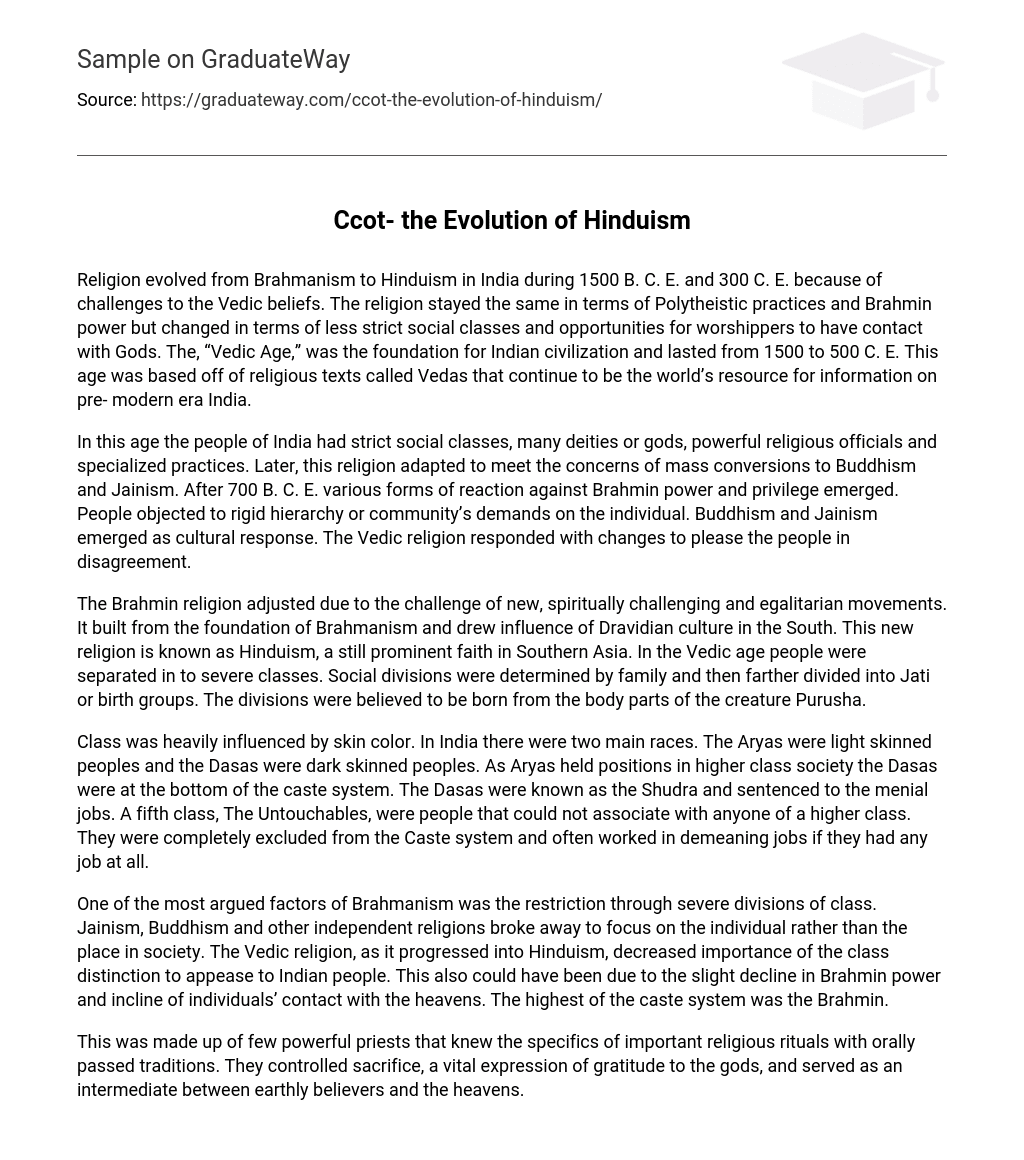Religion in India underwent a transformation from Brahmanism to Hinduism between 1500 B. C. E. and 300 C. E. due to challenges faced by Vedic beliefs. While Polytheistic practices and the influence of Brahmins remained unchanged, there were modifications in terms of social class regulations becoming less strict and devotees gaining increased access to deities. The period known as the “Vedic Age,” which spanned from 1500 to 500 C. E., laid the foundation for Indian civilization and relied on religious texts called Vedas, which still serve as a valuable source of knowledge about ancient India.
During this time in India, there were strict social classes, numerous deities, influential religious officials, and specialized practices. Eventually, the religion evolved to accommodate the conversion of masses to Buddhism and Jainism. Around 700 B.C.E., different forms of resistance against Brahmin authority and privilege began to arise. Individuals protested against the rigid hierarchy and the community’s expectations of them. Buddhism and Jainism emerged as cultural responses to these issues. The Vedic religion made changes in order to appease those who disagreed with its practices.
Hinduism, which emerged as a result of new spiritual and egalitarian movements, adapted the Brahmin religion by incorporating elements from Dravidian culture in the South. This religion, still widely practiced in Southern Asia, evolved from Brahmanism. During the Vedic age, society was divided into various classes based on family lineage and further categorized into Jati or birth groups. These divisions were believed to have originated from different body parts of the creature Purusha.
In India, skin color played a significant role in determining social class. There were two main racial groups: the Aryas with light skin and the Dasas with dark skin. The Aryas occupied higher positions in society, while the Dasas were placed at the lowest rung of the caste system called Shudra. Besides this hierarchy, there existed a distinct group known as The Untouchables who were completely excluded from the Caste system and forbidden from associating with individuals in higher classes. Regrettably, The Untouchables frequently found themselves engaged in degrading jobs or unemployed.
The division of class was a highly debated aspect of Brahmanism. However, Jainism, Buddhism, and other independent religions separated from this system and emphasized individuality over social status. As Vedic religion evolved into Hinduism, the significance of class distinctions decreased in order to satisfy the Indian population. This shift may have been influenced by the diminishing power of the Brahmin class and increased interaction between individuals and heavenly forces. Notably, the Brahmin caste held the highest position in the caste system.
This group consisted of a small number of influential priests who possessed knowledge about significant religious ceremonies passed down orally. They held authority over sacrificial rituals, which were essential acts of thanks to the deities, and acted as intermediaries between devout individuals and the divine realm. Due to their dominance in crucial ceremonies, the Brahmin priests could effortlessly preserve their power and ensure economic prosperity within Indian society. This Brahmin authority stood as the second most significant challenge to Vedic religion.
Brahmanism underwent a shift in focus, with less emphasis on the power of the Brahmins while still maintaining their status. The importance of sacrifice diminished and individuals had more opportunities to directly connect with the gods. This was made possible by the increase in the number of deities, allowing people to establish connections based on specific qualities. Additionally, worshippers were presented with various paths to attain divine favor, such as embarking on pilgrimages to shrines, practicing devotion, and enduring extreme discipline. The presence of polytheism continued to be a fundamental component of Indian religion.
Despite not including the worship of gods from opposing religions, the Vedic religion has retained its fundamental belief in multiple deities. Hinduism has gradually witnessed an expansion in the number of gods over time. Some gods can be traced back to ancient Vedic culture, while others have origins in South Indian Dravidian culture. Additionally, certain deities have been newly created. Presently, it is estimated that there are three hundred and thirty million unique gods within Hinduism. These numerous divine beings play a crucial role as an integral component of the religion.
Even after religious reform, Brahmin priests still held ultimate power in Indian society and maintained political influence. Although sacrifice became less important, the Brahmin class remained an integral part of the religion. Each class had specific religious duties based on gender and life stage. For a young man from the Brahmin class, this involved undergoing a ceremony to acknowledge his entrance into manhood and then living an “Ideal lifestyle.” The role of the priests remained fundamental during the transition from Vedic to Hinduism.
By 500 C. E., Brahmanism had undergone a transformation and evolved into what is now known as Hinduism. Between 1500 B. C. E. and 500 C. E., Brahmanism in India experienced changes in terms of social divisions and communication with the divine, while retaining its polytheistic practices and the dominance of the Brahmin caste. This religious evolution can be compared to the Catholic Reformation in the Latin West, where opposing religions like Jainism and Buddhism played a role in shaping beliefs, similar to how Protestantism emerged as a strong force during the Reformation in Catholicism.





